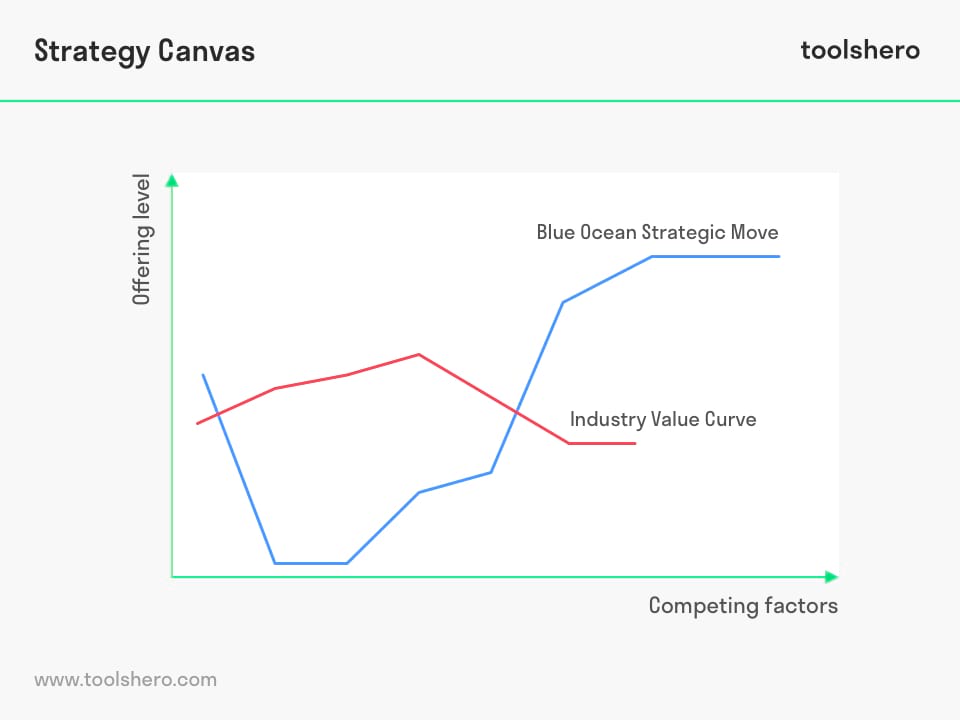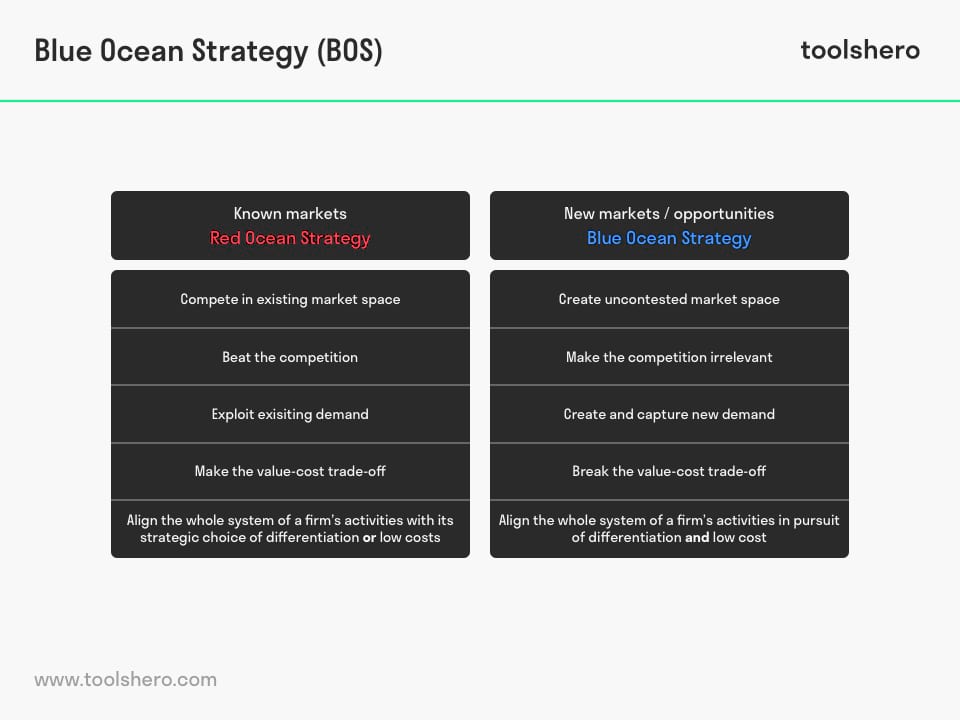Blue Ocean Strategy: theory and examples

Blue Ocean Strategy: this article explains the Blue Ocean Strategy (BOS), developed by W. Chan Kim and Renée Mauborgne, in a practical way. This summary covers what Blue Ocean Strategy is, how it compares to Venture Strategy and Red Ocean Strategy, and what the role of value innovation is. It furthermore provides the Blue Ocean Strategy Canvas and explains what the 4 Actions Framework is. It concludes with advantages, disadvantages and principles of Blue Ocean Strategy. Enjoy reading!
What is Blue Ocean Strategy?
The Blue Ocean Strategy (BOS) is the strategic organizational approach that is based on the principle that companies should not engage in a competitive struggle and experience market boundaries, but that they should focus more on uncontested markets.
Blue Ocean Strategy has been developed by W. Chan Kim and Renée Mauborgne and is based on a study of 150 strategic moves in the course of one hundred years and over 30 industries. In example like Apple, Cirque Du Soleil, Yellow Tail and Air Asia.
Blue Ocean Strategy was followed by the book Blue Ocean Shift, by both Chan Kim and Mauborgne, professors of strategy.
W. Chan Kim and Renée Mauborgne contend that future leading companies are likely to succeed by targeting uncontested markets that are ready for growth and development.
They call these markets ‘blue oceans’. Its counterparts are called bloody red oceans.
Unconscious process
This strategic move provides value development both for the organizations themselves and for potential buyers.
The basic principle of Blue Ocean Strategy is to map out, in addition to the (already) known markets (‘red oceans’), the ‘blue oceans’. These blue oceans document new markets and new opportunities.
Furthermore, it is surprising that ‘blue oceans’ are already used and applied unconsciously by strategists in the current strategies.
This strategy especially tries to offset this unconscious part in an analytical framework. With the necessary resources, ‘blue oceans’ can be created and recorded successfully.
Venture strategy
Blue Ocean Strategy is often compared to Venture strategy. Venture strategies have been used by large multinationals for decades. However, there is a large difference between these two approaches.
Venture strategies are specifically about the technological innovation of companies towards a dynamic market. Blue Ocean Strategy is about value innovation in general, in which no emphasis is put on reducing the speed to market.
Value Innovation
Unlike many conventional approaches to strategy formation, Chan Kim and Mauborgne chose not to focus on the competition, but on the customer. In their logic, as much attention is paid to value creation as to innovation.
This leads to a new concept: value innovation. The combination of these two ensures that innovation is not only driven by technology, but by what is better for customers.
Value Innovation is only spoken of when companies gear their innovation activities to utility, cost and price. This means, for instance, that companies generally have to abandon the competition-based theories, such as the Generic Strategies of Porter.
These state, for example, that companies must make a choice between low costs and differentiation. Managers who want to develop Blue Ocean Strategies strive for differentiation and low costs at the same time. It’s about reducing costs, but at the same time increasing value for buyers.
If there are improvements in utility or price, or costs, the value to the consumer will increase. Even when the cost structure is improved, costs will be reduced. Together, these measures will enable value innovation that benefits both the customer and the organisation.
The difference between Blue Ocean Strategy and Red Ocean Strategy
The red oceans are all industries and sectors that currently exist: the well-known market. In red oceans, borders have long been defined and accepted. The competitive rules of the game are well known, and the whole thing works smoothly.
In such an environment, companies try to outperform other companies in order to control a larger part of the existing market. As the market space becomes full of providers, profits and growth are inhibited. At a certain point, products are seen as raw materials, which leads to bloody competition. For this reason, the term ‘red’ has also been assigned to such an overall strategy.
The blue oceans, on the other hand, are all industries that do not exist or are known today. This is the unknown market. Completely unaffected by competition, in blue oceans demand is created instead of fought. In such an environment, there is ample opportunity for growth that is both rapid and profitable.
In these blue oceans, competition is irrelevant. The rules of the game have yet to be drawn up, there are no large market share holders, and there is sufficient potential. A blue ocean is an analogy, to describe the deeper potential that can be found in environments where no company has ever been present.
A blue ocean is deep, powerful and large, as is the potential for profit.
Blue Ocean Strategy Canvas
In order to discover how value innovation can be achieved, the Blue Ocean Strategy Canvas is used. The Blue Ocean Strategy Canvas is part of the same study of W. Chan Kim and Renee Mauborgne.
The framework has two purposes. The first objective is to record the current state of affairs in the current market. This includes identifying factors on which players in the industry are competing.

Figure 1 – Blue Ocean Canvas by (Kim & Mauborgne)
4 Actions Framework of Chan Kim and Renee Mauborgne
In order to help entrepreneurs to think innovative about the products they make in relation to the industry, the same researchers developed the 4 Actions Framework. Instead of wasting resources worrying about balancing cost and value, Blue Ocean Strategy helps maximize user value, reduce costs, eliminate unnecessary product features, and increase user profit.
The 4 Actions Framework consists of the following steps:
- Step 1: Eliminate
- Step 2: Reduce
- Step 3: Increase
- Step 4: Create
The 4 Actions Framework of W. Chan Kim and Renee Mauborgne helps to assess whether money is spent correctly around its production. By optimising this, the profit for the user is maximised, and the pains are minimised. Only the pains that really matter to the consumer should be included in the 4 Actions Framework.
Applying the 4 Actions Framework
As part of the Blue Ocean Strategy, it is advisable to apply the 4 Actions Framework as an entrepreneur looking for ways to be more innovative in the production of products.
Step 1: Eliminate
The 4 Actions Framework is usually visualised in a template, consisting of four columns. In each column, it is important to ask the right questions about the industry standards of the product in question.
First, ask yourself for which factors companies have been competing for a long time. Think of the factors that require a lot of investment but do not generate a lot of income, or other factors that do not improve the statistics.
Step 2: Reduce
In step 2, think about which factors need to be reduced well below the industry. Think of characteristics of a certain product that have been designed to beat the competition, but that cost a lot of time and resources. Can this initiative be reduced to something simpler with lower costs, but still remain competitive, interesting and relevant to users?
Step 3: Increase
The fourth action point of the 4 Actions Framework from the Blue Ocean Strategy is increasing. Think about which factors are well above the industry standard. Which user pain points does the current market not yet address? How can I come up with functions that make the pain points of this group of people disappear?
Step 4: Create
The final action point concerns the factors to be created that the industry has never offered. This is one of the most challenging questions, but at the same time one with the most potential.
It requires an in-depth understanding of the organisation and industry, as well as consumers’ interests and desires and the direction the market is heading in. The aim of this last action point is to think about the future and about the challenges that customers have not yet formulated.
Manual 4 Actions Framework Blue Ocean Strategy
The 4 Actions Framework / BOS Framework from the Blue Ocean Strategy is particularly valuable when an entrepreneur is trying to achieve value innovation and break up the cost trade-off between value and cost. The developers of this method use terms of red and blue oceans to describe the global market.
As the market becomes full, the prospects for profit and growth are reduced. Blue oceans, on the other hand, are the markets that do not yet exist, so there is still a lot of potential there for organisations if they get there first.
In the blue oceans, demand is created instead of fought. When a company is stuck in a red ocean, or would like to differentiate alongside a business in the already existing market, the 4 Actions Template is a great tool.
Advantages and disadvantages Blue Ocean Strategy
Below are some of the benefits of the BOS method when applied correctly.
- BOS as an organisation collaborates with various organisations to find new markets and avoid saturated markets.
- Implementation of the BOS helps to overcome the barriers of competition within an existing market and cost structure and gradually transform into constructive improvements in value.
- Value innovation is the foundation of a BOS. It ultimately creates new value and demand for consumers and thus increases the likelihood of growth potential.
- BOS enable fundamental transformations in mentality. It also helps in recognising opportunities.
- The BOS method is based on proven data rather than unproven theories.
Some disadvantages of using a Blue Ocean Strategy are:
- It can be difficult to come up with futuristic ideas and identify colossal and unused markets.
- The development of a successful BOS is the result of a calculated and detailed research supported by extensive analyses. Keep in mind that this is not a magic formula, or an easy DIY job.
- Entering the market in the initial phase of a new market is risky. Chances are that customers do not understand the foundation of a product or service due to the lack of a fully developed technology.
- Tapping into a new market is not easy. An organisation must be clear and smart about its customer base, and ways to expand it. It therefore requires a great deal of clarity about the considerations that are being made, as well as obstacles.
- Choosing an ocean other than the Blue Ocean Strategy requires a lot of patience, perseverance, preparation and faith. An existing market is not completely closed, but tapping into a new market with an innovative product is, according to the creators behind the Blue Ocean Strategy, one of the better things an entrepreneur can decide to do.
Six principles of the Blue Ocean Strategy
This strategy targets six principles that can be used in every organization so that they can arrive at a successful development and fulfilment of new markets. A distinction is made between preliminary and executive principles.

Figure 2 – Blue Ocean Strategy (BOS) vs. Red Ocean Strategy (ROS)
Preliminary principles
- reconstruct market boundaries
- focus on the big picture, not the numbers in the here and now
- reach beyond the existing supply and demand
- approach the right strategic sequence
Executive principles
- overcome the main organizational hurdles
- build in victory into the organizational strategy
W. Chan Kim and Renée Mauborgne are convinced that the Blue Ocean Strategy can break through all existing paradigms and ideas about traditional strategies. Organizations should not be afraid to deviate from the traditional paths.
Now It’s Your Turn
What do you think? Is the Blue Ocean Strategy applicable in today’s modern economy and business world? Do you recognize the practical explanation or do you have more suggestions? What are your success factors for the good competitive strategy?
Share your experience and knowledge in the comments box below.
More information
- Kim, W. C. & Mauborgne, R. (2007). Blue ocean strategy. Leadership Excellence, 9, 20-21.
- Kim, W. C. & Mauborgne, R. (2005). Blue Ocean Strategy: How to create uncontested market space and make the competition irrelevant. Harvard Business School Press.
- Kim, W. C. & Mauborgne, R. (2005). Value innovation: a leap into the blue ocean. Journal of business strategy, 26(4), 22-28.
How to cite this article:
Janse, B. (2020). Blue Ocean Strategy (BOS). Retrieved [insert date] from Toolshero: https://www.toolshero.com/strategy/blue-ocean-strategy/
Original publication date: 03/14/2018 | Last update: 12/24/2023
Add a link to this page on your website:
<a href=”https://www.toolshero.com/strategy/blue-ocean-strategy/”>Toolshero: Blue Ocean Strategy (BOS)</a>












